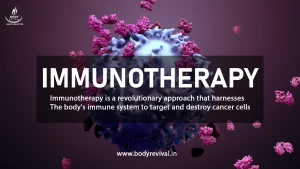Cancer treatment has long relied on chemotherapy, despite the significant side effects that can be challenging for patients. Thanks to continuous research in the field of cancer, there are many alternate cancer treatments to chemotherapy are available.
Although chemotherapy effectively targets and eliminates fast-growing cancer cells, it also harms healthy cells that divide rapidly. These healthy cells include those in the hair follicles, digestive tract, and bone marrow.
There has been a growing interest in alternate cancer treatments which have lesser side-effects. These therapies provide effective treatment with fewer side effects. In this blog, we will explore five promising alternatives to chemotherapy that are making significant strides in the field of oncology.
1. Immunotherapy
Immunotherapy is a revolutionary approach that harnesses the body’s immune system to target and destroy cancer cells.

Unlike chemotherapy, which can harm healthy cells, immunotherapy specifically targets cancer cells, minimizing collateral damage. They can provide lasting responses and improved survival rates. It’s a great alternate cancer treatment for cases that don’t respond well to traditional therapies.
Risks associated with Immunotherapy
Immunotherapy does pose certain risks of triggering reactions. By activating the immune system, it can lead to side effects like fever, chills, and fatigue. Some forms of immunotherapy may also result in issues such as swelling, weight gain, heart palpitations, or diarrhoea.
2. Targeted Therapy
Targeted therapy is an approach that identifies specific molecules or pathways responsible for cancer growth. Drugs designed to target these precise factors are then administered to inhibit tumour growth. This approach is a great alternate cancer treatment in cases where cancer has a known genetic mutation.
Risks associated with Target Therapy
The risks often encompass common issues like diarrhoea and liver complications. Additionally, individuals might experience challenges related to blood clotting and wound healing, as well as fatigue, elevated blood pressure, and skin concerns.
3. Hormone Therapy
Hormone therapy is effective in treating hormone-receptor-positive breast and prostate cancers. It works by blocking hormones like oestrogen or testosterone, which fuel the growth of these cancer types. Hormone therapy can be administered orally or through injections. This makes it an amazing less invasive alternate cancer treatment option.
Risks associated with Hormone Therapy
The potential side effects vary based on the treatment. In males undergoing hormone therapy for prostate cancer, some common side effects include reduced sex drive, erectile dysfunction, bone density loss, fatigue, and weight gain.
On the other hand, females undergoing hormone therapy may encounter reduced sexual desire, bone density loss, fatigue, nausea, and an elevated risk of other types of cancer.
4. Radiation Therapy
Radiation therapy uses high-energy rays that target and destroy cancer cells. Technological advancements, such as intensity-modulated radiation therapy (IMRT) and proton therapy, allow for more precise targeting, reducing damage to surrounding healthy tissue. This makes radiation therapy a viable alternate cancer treatment to chemotherapy, particularly for localised tumours.
Risks associated with Radiation Therapy
The primary initial side effects typically involve fatigue, causing a sense of tiredness, and alterations in the skin. Additional early side effects often pertain to the specific treated area. For instance, hair loss and mouth issues may arise if radiation treatment targets this particular region.
5. Angiogenesis Inhibitors
Angiogenesis inhibitors are drugs that block the formation of new blood vessels that feed tumours. By starving cancer cells of their blood supply, these drugs can slow or stop tumour growth. They are often used in combination with other therapies and have shown promise in treating various types of cancer.
Risks Associated with Angiogenesis Inhibitors
Angiogenesis is crucial for many of the body’s regular functions. Consequently, angiogenesis inhibitors can lead to a wide array of physical side effects, such as:
- Elevated blood pressure
- Skin issues like rashes or dry, itchy skin
- Hand-foot syndrome, which can cause tender and thickened areas on your palms and soles, sometimes leading to blisters
- Diarrhoea
- Fatigue
- Decreased blood cell counts
- Challenges with wound healing or the reopening of cuts
While these side effects are relatively common, they don’t necessarily occur with every drug or every individual.
Things to keep in mind when going for alternate cancer treatment
While chemotherapy remains a crucial tool in the fight against cancer, it’s heartening to see the rapid advancement of alternative therapies for cancer that offer more targeted, less toxic treatment options.
These alternative cancer treatments are changing the landscape of cancer care, providing hope and improved quality of life for many patients.
It’s important to note that the choice of treatment should always be based on an individual’s specific diagnosis, and consultation with a healthcare team is essential to determine the most suitable approach.